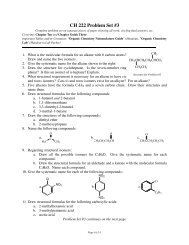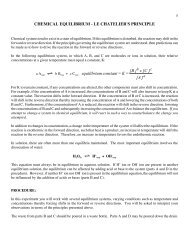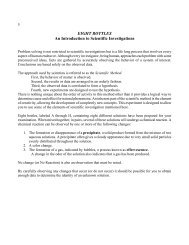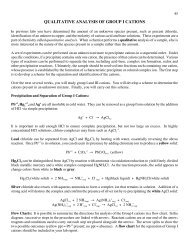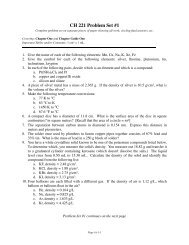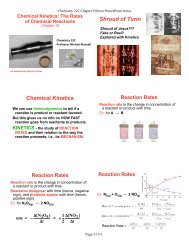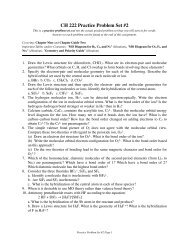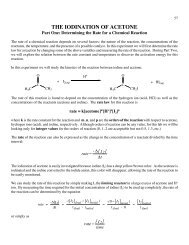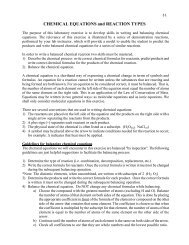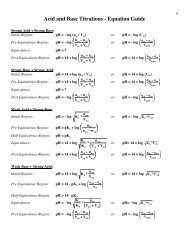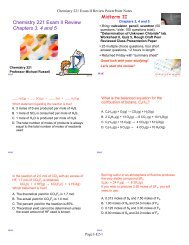CH 221 Problem Set #4
CH 221 Problem Set #4
CH 221 Problem Set #4
- No tags were found...
Create successful ePaper yourself
Turn your PDF publications into a flip-book with our unique Google optimized e-Paper software.
<strong>CH</strong> <strong>221</strong> <strong>Problem</strong> <strong>Set</strong> <strong>#4</strong>Complete problem set on separate pieces of paper showing all work, circling final answers, etc.Covering: Chapter Three & Chapter Four and Chapter Guide FourImportant Tables and/or Constants: Figure 3.10 (page 122 - Solubility Guidelines), Solubility Table (Net Ionics lab- Use the Net Ionics solubility table when answering questions about solubility in <strong>CH</strong> <strong>221</strong>)1. Balance the following equations:a. Cr(s) + Cl2(g) → CrCl3(s)b. SiO2(s) + C(s) → Si(s) + CO(g)c. Fe(s) + H2O(g) → Fe3O4(s) + H2(g)2. Balance the following equations and name each reactant and product:a. SF4(g) + H2O(l) → SO2(g) + HF(l)b. NH3(aq) + O2(aq) → NO(g) + H2O(l)c. BF3(g) + H2O(l) → HF(aq) + H3BO3(aq)3. What mass of HCl, in grams, is required to react with 0.750 g of Al(OH)3? What mass ofwater, in grams, is produced? What mass of AlCl3, in grams, is produced? Theequation: Al(OH)3(s) + 3 HCl(aq) → AlCl3(aq) + 3 H2O(l)4. Hexane (C6H14) burns in air (O2) to give CO2 and H2O. Write a balanced equation for thisreaction. If 215 g of C6H14 is mixed with 215 g of O2, what masses of CO2 and H2O areproduced in the reaction? What mass of excess reactant remains at the end of the reaction?5. Consider the reaction: 2 <strong>CH</strong>3SH + CO → <strong>CH</strong>3COS<strong>CH</strong>3 + H2S. If you begin with 10.0 gof <strong>CH</strong>3SH and excess CO,a. What is the theoretical yield of <strong>CH</strong>3COS<strong>CH</strong>3?b. If 8.65 g of <strong>CH</strong>3COS<strong>CH</strong>3 is isolated, what is the percent yield?6. A 2.634 g sample containing impure CuCl2 . 2 H2O was heated. The sample mass afterheating to drive off the water was 2.125 g. What was the mass percent of CuCl2 . 2 H2O inthe original sample?7. Saccharin, an artificial sweetener, has the formula C7H5NO3S. Suppose you have a sample ofa saccharin-containing sweetener with a mass of 0.2140 g. After decomposition to free sulfurand converting it to the SO4 2- ion, the sulfate ion is trapped as the water-insoluble BaSO4.The quantity of BaSO4 obtained is 0.2070 g. What is the mass percent of saccharin in thesample of sweetener?8. To find the formula of a compound composed of iron and carbon monoxide, Fex(CO)y, thecompound is burned in pure oxygen to give Fe2O3 and CO2. If you burn 1.959 g of Fex(CO)yand obtain 0.799 g of Fe2O3 and 2.200 g of CO2, what is the empirical formula of Fex(CO)y?9. Mesitylene is a liquid hydrocarbon. Burning 0.115 g of the compound in oxygen gives 0.379g of CO2 and 0.1035 g of H2O. What is the empirical formula of mesitylene?10. Quinone, a chemical used in the dye industry and in photography, is an organic compoundcontaining only C, H and O. What is the empirical formula of the compound if 0.105 g of thecompound gives 0.257 g of CO2 and 0.0350 g of H2O when burned completely in oxygen?<strong>Problem</strong> <strong>Set</strong> <strong>#4</strong> continues on next pagePage iA-4-1
<strong>Problem</strong> <strong>Set</strong> <strong>#4</strong>, Continued from previous page11. Decide whether each of the following is water-soluble. If soluble, tell what ions areproduced.a. NiCl2b. Cr(NO3)3c. Na2C2O4d. BaSO412. Predict the products of each precipitation reaction. Balance the completed equation, and thenwrite the net ionic equation.a. Pb(NO3)2(aq) + KBr(aq) →b. Ca(NO3)2(aq) + KF(aq) →13. Balance the following equations, and then write the net ionic equation. Identify the spectatorions, if any.a. Mg(OH)2(s) + HCl(aq) → MgCl2(aq) + H2O(l)b. HNO3(aq) + CaCO3(s) → Ca(NO3)2(aq) + H2O(l) + CO2(g)Page iA-4-2



